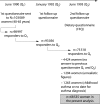Fruit and vegetable intakes and asthma in the E3N study
- PMID: 16396945
- PMCID: PMC1974844
- DOI: 10.1136/thx.2004.039123
Fruit and vegetable intakes and asthma in the E3N study
Abstract
Background: A study was undertaken to investigate whether dietary intake predicted the prevalence of adult asthma among French women participating in the E3N study.
Methods: Of 68 535 women who completed a food frequency questionnaire in 1993 which included 238 food items, 2145 (3.1%) reported having asthma. The distribution of food intake was divided into quartiles (Q(1)-Q(4)) and the prevalence of asthma was compared between the different quartiles (lowest as reference) using logistic regression models on cross sectional data.
Results: After adjusting for age, body mass index, menopausal status, smoking status, total caloric intake, physical activity, and use of dietary supplements, women who had a greater intake of tomatoes (OR(Q1-Q4) 0.85 95% CI 0.75 to 0.96, test for trend p = 0.02), carrots (OR(Q1-Q4) 0.81 95% CI 0.72 to 0.92, test for trend p = 0.0003), and leafy vegetables (OR(Q1-Q4) 0.82 95% CI 0.73 to 0.93, test for trend p = 0.0009) had a lower prevalence of asthma. Apples were marginally related to the prevalence of asthma. No other fruits or vegetables were significantly associated with asthma prevalence.
Conclusions: These results suggest that the intake of some vegetables may decrease the prevalence of adult asthma.
Conflict of interest statement
Competing interests: none declared.
Similar articles
-
Adherence to the Mediterranean diet and fresh fruit intake are associated with improved asthma control.Allergy. 2008 Jul;63(7):917-23. doi: 10.1111/j.1398-9995.2008.01665.x. Allergy. 2008. PMID: 18588559
-
Intake of fruits and vegetables in relation to 10-year weight gain among Spanish adults.Obesity (Silver Spring). 2008 Mar;16(3):664-70. doi: 10.1038/oby.2007.121. Epub 2008 Jan 17. Obesity (Silver Spring). 2008. PMID: 18239583
-
Diet, wheeze, and atopy in school children in Menorca, Spain.Pediatr Allergy Immunol. 2007 Sep;18(6):480-5. doi: 10.1111/j.1399-3038.2007.00596.x. Pediatr Allergy Immunol. 2007. PMID: 17680906
-
Fruit and vegetable consumption and the risk of proximal colon, distal colon, and rectal cancers in a case-control study in Western Australia.J Am Diet Assoc. 2011 Oct;111(10):1479-90. doi: 10.1016/j.jada.2011.07.008. J Am Diet Assoc. 2011. PMID: 21963014
-
Fruit and vegetable consumption and risk of cholecystectomy in women.Am J Med. 2006 Sep;119(9):760-7. doi: 10.1016/j.amjmed.2006.02.040. Am J Med. 2006. PMID: 16945611
Cited by
-
Health Status of Female and Male Vegetarian and Vegan Endurance Runners Compared to Omnivores-Results from the NURMI Study (Step 2).Nutrients. 2018 Dec 22;11(1):29. doi: 10.3390/nu11010029. Nutrients. 2018. PMID: 30583521 Free PMC article.
-
Association between kimchi intake and asthma in Korean adults: the fourth and fifth Korea National Health and Nutrition Examination Survey (2007-2011).J Med Food. 2014 Jan;17(1):172-8. doi: 10.1089/jmf.2013.3013. J Med Food. 2014. PMID: 24456368 Free PMC article.
-
Protective effect of fruits, vegetables and the Mediterranean diet on asthma and allergies among children in Crete.Thorax. 2007 Aug;62(8):677-83. doi: 10.1136/thx.2006.069419. Epub 2007 Apr 5. Thorax. 2007. PMID: 17412780 Free PMC article.
-
Association between dietary carotenoid intakes and the risk of asthma in adults: a cross-sectional study of NHANES, 2007-2012.BMJ Open. 2022 Jun 14;12(6):e052320. doi: 10.1136/bmjopen-2021-052320. BMJ Open. 2022. PMID: 35701051 Free PMC article.
-
Is fruit and vegetable intake associated with asthma or chronic rhino-sinusitis in European adults? Results from the Global Allergy and Asthma Network of Excellence (GA2LEN) Survey.Clin Transl Allergy. 2017 Jan 27;7:3. doi: 10.1186/s13601-016-0140-9. eCollection 2017. Clin Transl Allergy. 2017. PMID: 28149501 Free PMC article.
References
-
- Romieu I, Trenga C. Diet and obstructive lung diseases. Epidemiol Rev 200123268–287. - PubMed
-
- Heffner J E, Repine J E. Pulmonary strategies of antioxidant defense. Am Rev Respir Dis 1989140531–554. - PubMed
-
- Repine J E, Bast A, Lankhorst I. Oxidative stress in chronic obstructive pulmonary disease. Oxidative Stress Study Group. Am J Respir Crit Care Med 1997156341–357. - PubMed
-
- Kelly Y, Sacker A, Marmot M. Nutrition and respiratory health in adults: findings from the health survey for Scotland. Eur Respir J 200321664–671. - PubMed

